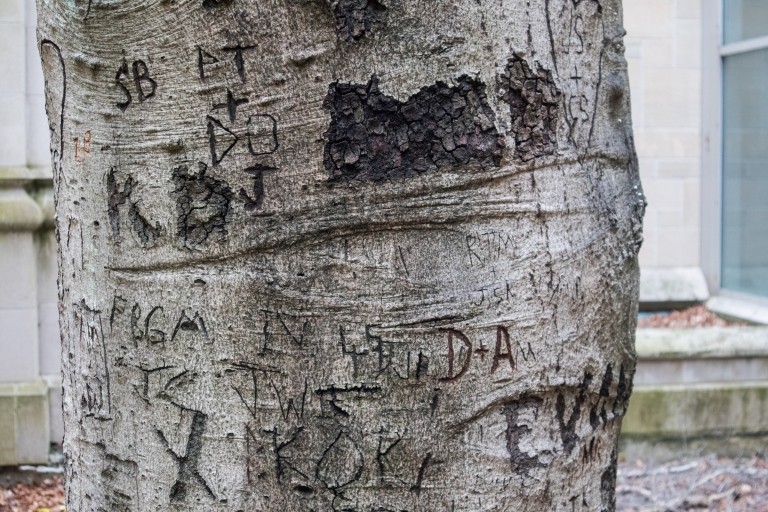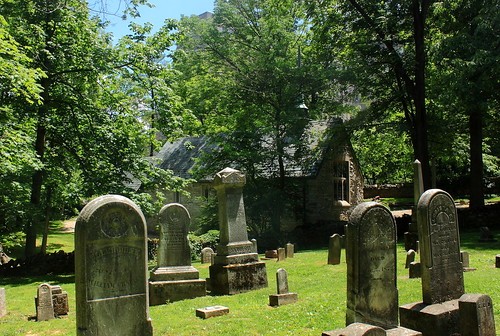The History of Dunn's Woods
Introduction
Text-to-speech Audio
Images
This is the sweetheart tree which the oldest daughter of the Dunn family and her significant other carved their initials into, setting an example for many couples in the future. It is now located at the center of the IU chemistry building courtyard.

These are few of the buildings included in the Old cCescent on the Indiana University campus. The old cresent refers to buildings which are built on part of the 20 acre purchase of woodland the university made from the Dunn family.
.jpg)
This is an image of the Dunn cemetery which is preserved exclusively for members of the Dunn family

This image perfectly depicts the natural surroundings visitors are able to observe in the woods as they walk on the brick paths.

Backstory and Context
Text-to-speech Audio
The beautiful Dunn's Woods, which are located on the eastern side of Indiana University’s campus, were once considered private property. In fact, the woodland used to cover a greater area of land up until the university expanded its grounds, building lecture halls where parts of the woods previously stood. To truly understand the value and significance of this outdoor area, it’s important to learn about the history of the woods and their prominence even before it was part of the Indiana University campus.
Before the establishment of Dunn's Woods as an outdoor area available for Indiana University students, faculty, and other visitors to explore, the same mass of land was owned by the Dunn Family. During the majority of the 19th century, the IU campus was much smaller in comparison to its current size and was located at nowadays Seminary Square Park. However, due to a fire which destroyed many of the buildings, the campus had to relocate. This is when the board decided to start building in the area surrounding Dunn's Woods, leading them to purchase the woodland from Moses Fell Dunn. The board went through quite a bit of deliberation before making the purchase but eventually settled on acquiring 20 acres at a price of six thousand dollars (Mincey 2009, 3). Because of Indiana University’s decision to purchase the land and initially have it be the heart of campus, the green space can now be enjoyed by many more members of the university and the public in comparison to when the area was considered private property over a century ago. Even as the campus has continued to expand, the University has made it a priority to preserve the tranquility of such a historically significant green space.
Although Indiana University’s negotiations with the Dunn family have been recorded to be relatively straightforward over the years, multiple speculations and rumors have still come up about the negotiations that were originally made. The three main stipulations include that the Dunn Family burial plot located on the property sold cannot be moved; anytime a tree is cut down, another must be planted in its place, and the location of the Sweetheart tree cannot be hindered. The deed, which officially granted Dunn's Woods to the new Indiana University Campus, does not mention anything about the family plot; however, a separate deed has been found which does preserve a portion of the land exclusively for members of the Dunn family. Moses’s father, George Dunn, drew up this deed 28 years before the land was signed over to IU. It stated, “In order to secure and perpetuate to the descendants of Eleanor Dunn, Nancy Alexander, and Jane Irvin who be buried within the plat of ground…and to those with whom they intermarry forever a place of private burial where they shall repose together as one family in the long night of death and rise up together as from one bed at the last day” (McCarthy 2018). Since the deed drawn up by George Dunn was signed in1855, only ancestors of George’s mother and his two aunts are allowed to be buried there. In terms of the validity of the rumor about every tree that is cut down having to be replaced, there has never been a formal policy implemented regarding the issue. However, Mia Williams, who is a university landscape architect, said that even though there is no formal policy, there is still a minimum replacement standard due to hindrance caused by construction, saying that for every one tree cut down three new ones should be planted. The last rumor about the sweetheart tree has also been found to be false. To provide some context, the tree is an American Beech and it is located in the center of the courtyard for the chemistry building. The legend associated with it states that the Dunn's issued an order to protect the tree because their oldest daughter and her significant other had carved their initials onto the trunk of that tree, giving it a sentimental worth. This created a precedent for other couples leading them to carve their initials as well, giving the university a reason to preserve it even though the deed to the woods does not indicate a mandated protection of the tree. In other words there is no written requirement for protecting the tree, but the university has chosen to because of the emotional connection so many individuals have to it (McCarthy 2018).
Sources
Bracalente, Anita . Indiana University’s Woodland Campus (2012), Library of American Landscape History. Accessed August 17th 2020. https://lalh.org/indiana-universitys-woodland-campus-2012/.
McCarthy, Kayla. True or False? Myths of IU, The Dunn Family, Pride of IU. January 20th 2018. Accessed August 17th 2020. https://pride.iu.edu/pride-and-tradition/iu-history/true-false-myths-of-iu/.
Mincey, Sarah . Fischer, Burney . The Woodland Campus. Edition First . Bloomington, Indiana . IU–B School of Public and Environmental Affairs , 2009.
https://news.iu.edu/stories/2018/04/iub/inside/16-sweetheart-tree-to-be-replaced-for-safety.html
https://strategicplan.iu.edu/plan/building.html
https://www.flickr.com/photos/29445095@N05/14306709670
https://cpf.iu.edu/about/units/landscape-architecture/index.html
